- The John Malkovich EXCLUSIVE
- Marlborough Hits 50
- The Six BEST wine books
- Ventoux – Next Century Wines
- Ageing English Fizz: How, Why and What
- The Ten Wines Never to be Without
- The New Face of Languedoc
- Ukraine – Wine not War
- Our WINES OF THE YEAR (2023)
- A Southern French Feast
- ORANGE WINE Part 1
- ORANGE WINE Part 2
- Ancient Vines to the Rescue in St Mont
- Light Strike: Wine’s Not-So-Secret Scandal
- Grower Champagne with Lea & Sandeman
- Going Gaga for Garnacha
- SASSICAIA – The Insider’s Guide
- UK Wine’s Counterculture
- News & Views
- Rías Baixas – Mists, Myths, Mariscos
- Rías Baixas – Albariño with Attitude
- Red Wine Headaches: A Eureka Moment?
- Wine and War – Palestine, Israel and Lebanon
- We Need To Talk About Rosé
- Wines to Combat Climate Change
Summary
There’s a new wave of English and Welsh wine producers disrupting the neat and tidy order of the classic UK wine scene. Guerrilla producers – cool kids who aren’t afraid to go off-piste and craft dangerous, divisive wines packed full of quirks and kinks. Their attitude? It’s better to be naughty than nice. As one winemaker says – he wants to make, ‘wines with a cheeky smile.’
In this wide-ranging episode we dive headlong into this world of creativity, experimentation and free thinking. Our journey takes us from wines made under a London railway arch to sheep savaging vines in a Welsh hillside – and we taste everything from orange wines to pet nat, col fondo, ‘grower’ English fizz and, ‘purple Welsh bubbles.’
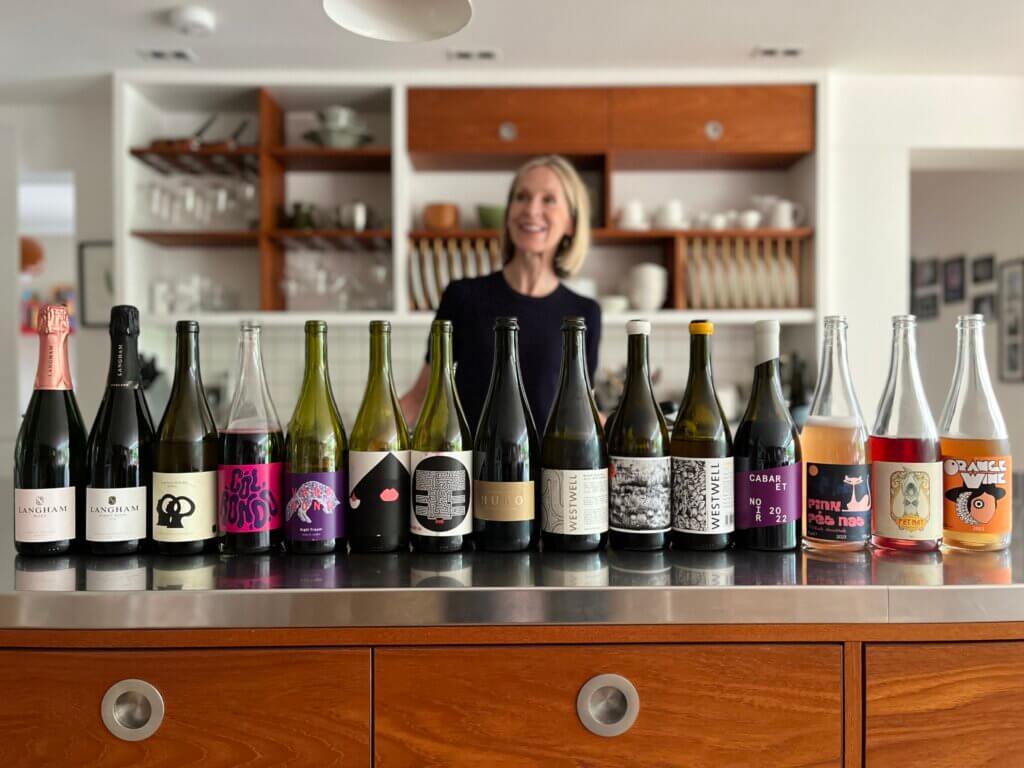
Starring
- Tommy Grimshaw, Langham Wine Estate
- Susan and James Kinsey-Jones, Whinyard Rocks
- Jose Quintana, Vagabond Wines
- Sergio Verrillo, Blackbook Winery
- Susie & Peter

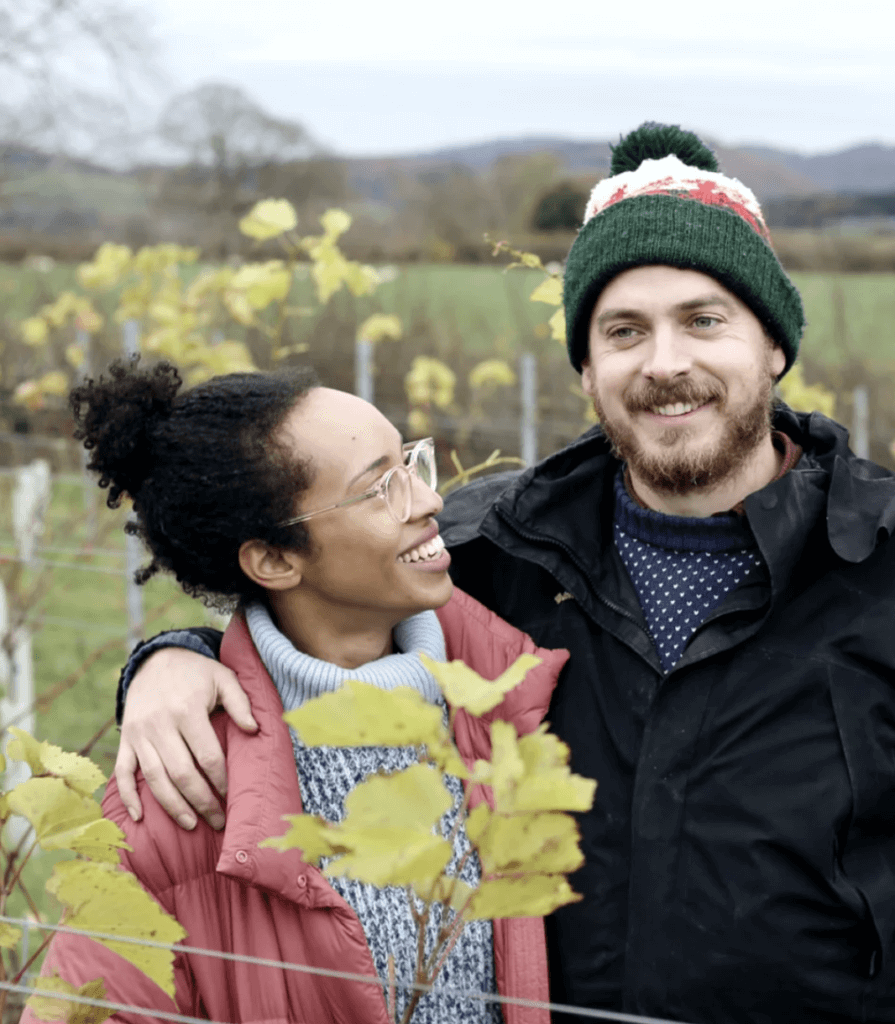


Links
- You can find our podcast on all major audio players: Apple Podcasts, Spotify, Google, Amazon, YouTube and beyond. If you’re on a mobile, the button below will redirect you automatically to this episode on an audio platform on your device. (If you’re on a PC or desktop, it will just return you to this page – in which case, get your phone out! Or find one of the above platforms on your browser.)
Wines
The following are English and Welsh wines we’ve tasted lately, and which we reference in the podcast.
If you’re based in the UK, you can generally buy direct from the wineries or from local independents. These are often small-batch wines so they can be hard to get old of before they sell out. (Which is also whey they are probably hard to find in other territories – sorry!)
- Langham Culver Classic Cuvée NV, 12% (£31.95, Langham)
- Langham Rosé NV, 12% (£34.95, Langham)
- Langham Brut Nature Pinot Noir 2019, 12% (£54.95, Langham)
- Langham Search for Enlightenment Chardonnay 2022, 11% (£23.95, Langham, from 29th April)
- Whinyard Rocks Col Rondo 2022, 12% (£25, Whinyard Rocks)
- Vagabond Night Tripper 2022, 13% (£30, Vagabond)
- Vagabond Solena Batch 002, 12% (£30, Vagabond)
- Blackbook Painter of Light Clayhill Chardonnay Reserve 2019, 12% (£35.50)
- Blackbook Crows Lane Estate Trouble Every Day Pinot Noir 2022, 13%
- Domaine Hugo Single Vineyard Brut Nature, 11.5% (£54)
- Westwell Blanc de Blancs 2013 Zero Dosage Brut, 12% (£42.50, Uncharted, Westwell)
- Westwell Pinot Meunier 2022, 11% (£26, Westwell)
- Westwell Ortega Skin Contact 2022, 10.5% (£26, Westwell)
- Ancre Hill ‘red’ Pét Nat Methode Ancestrale NV, 10% (£16.64)
- Ancre Hill Orange Wine 2022, 10%
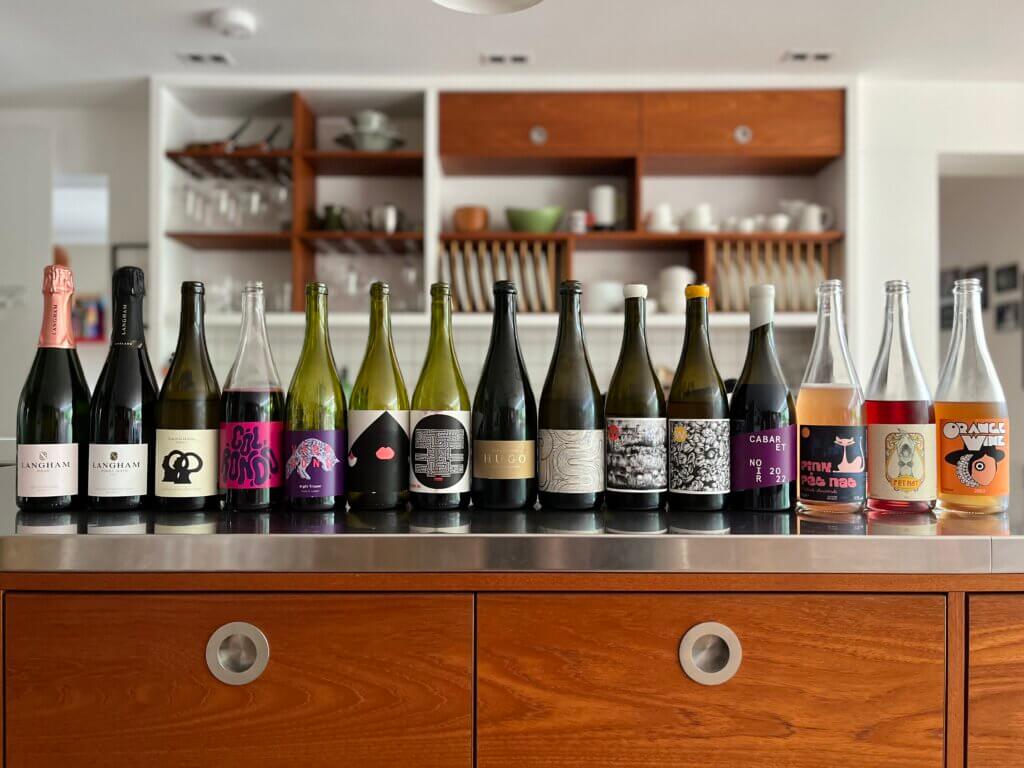
Behind the Scenes

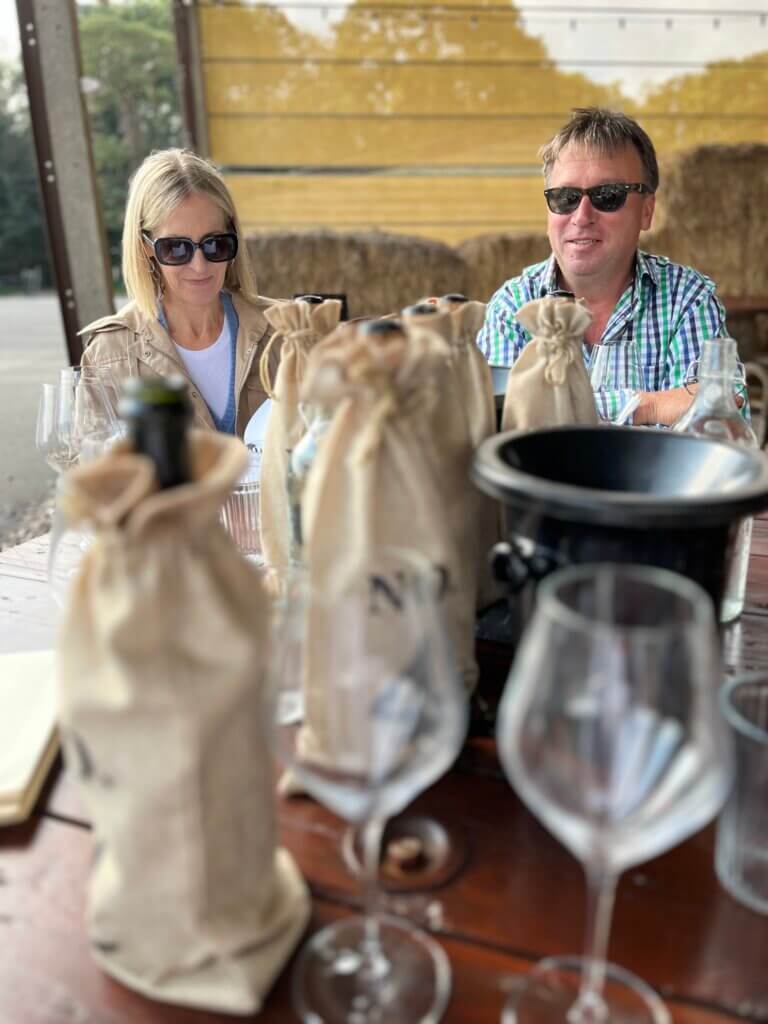
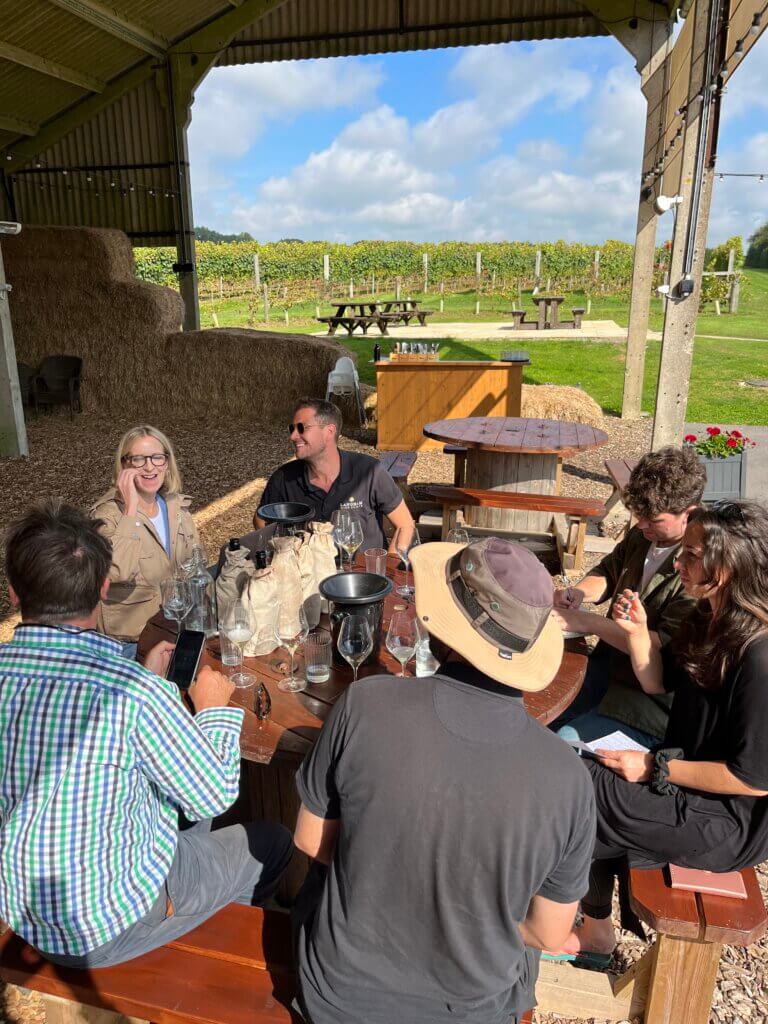
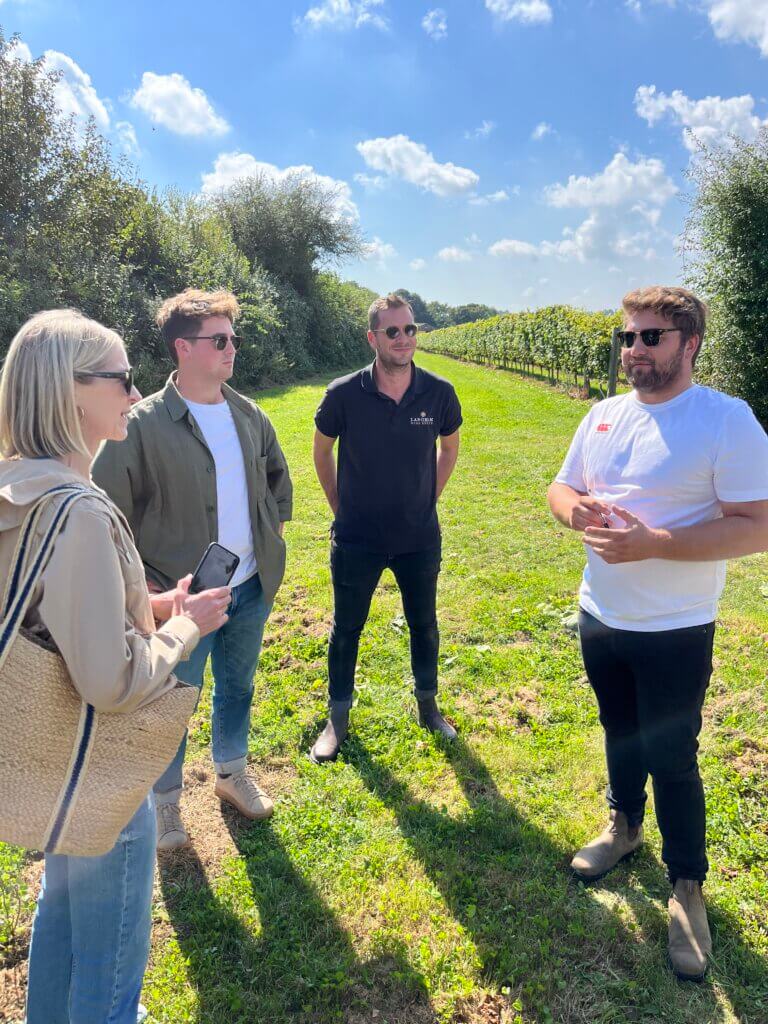
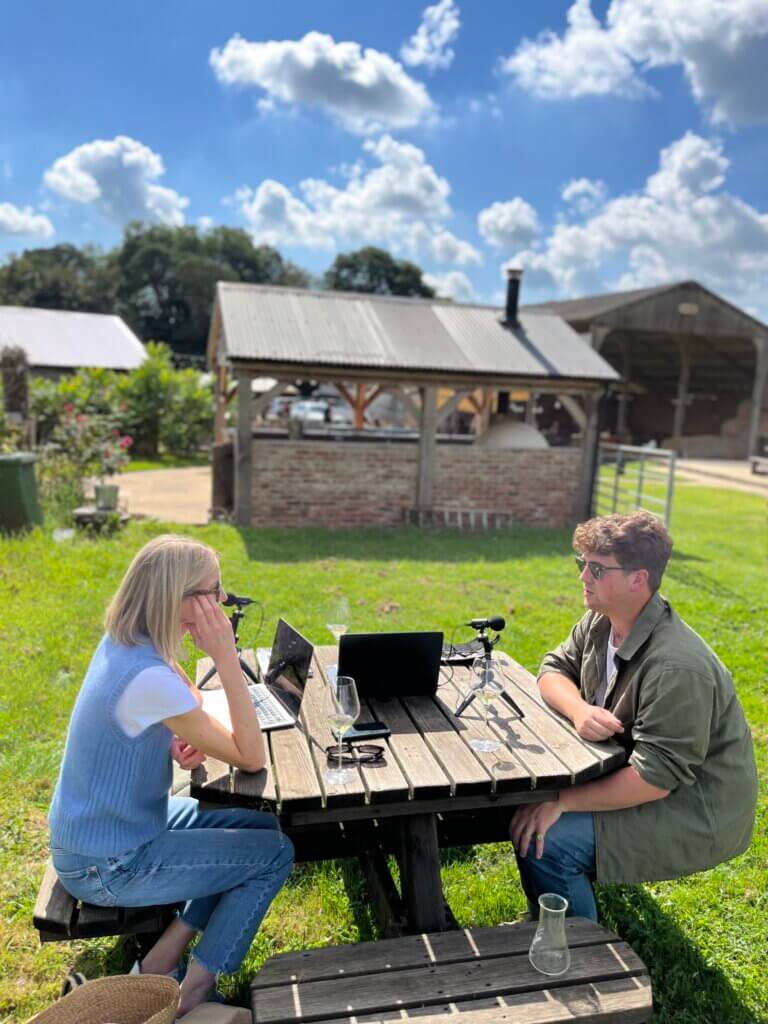
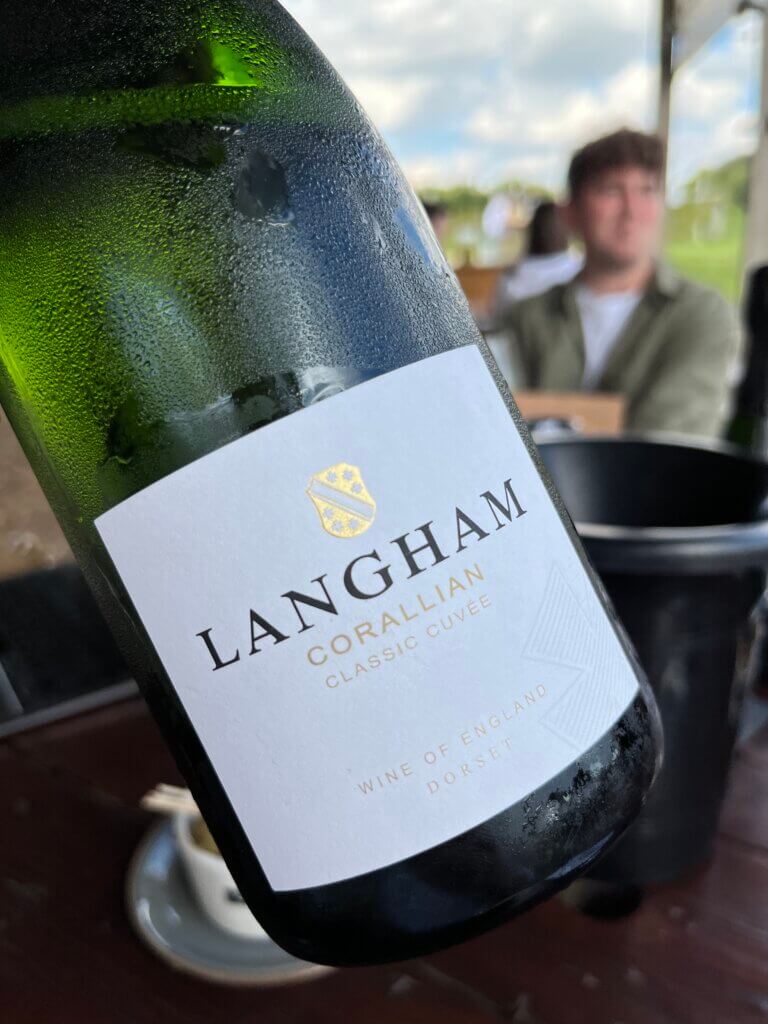
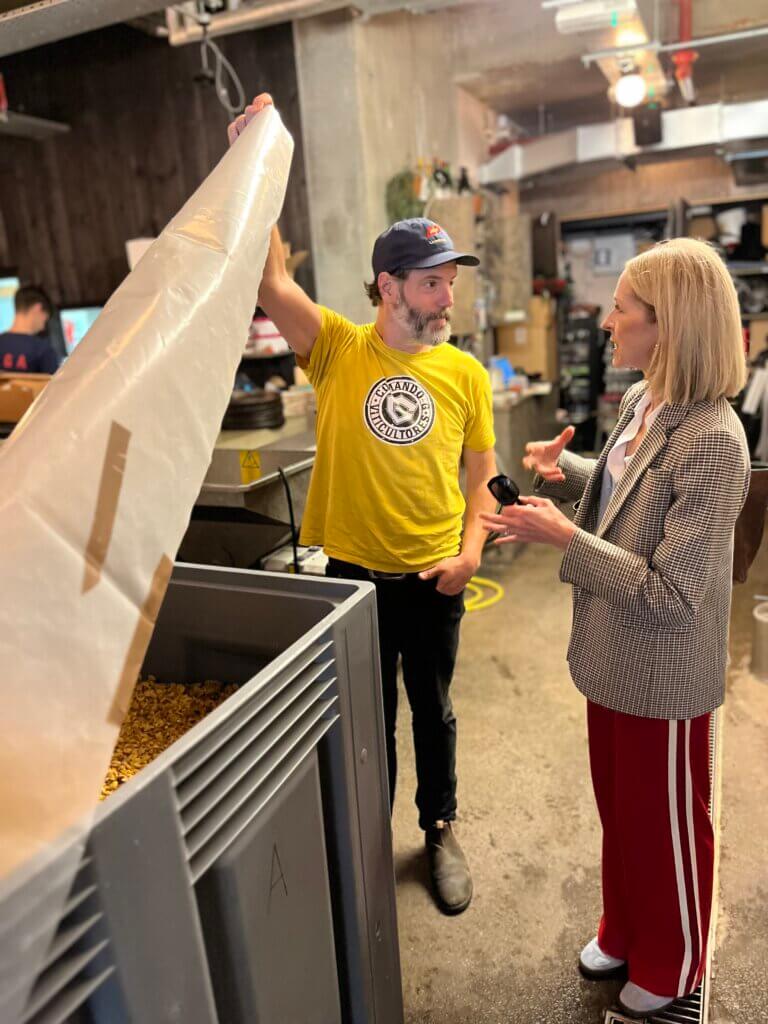
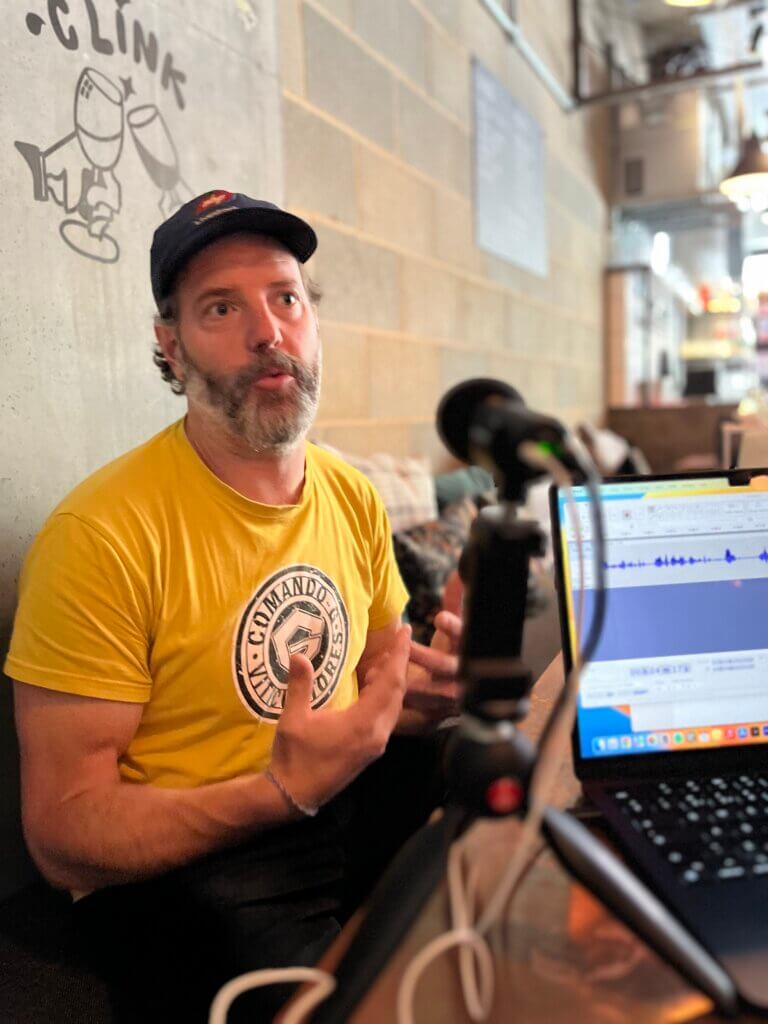


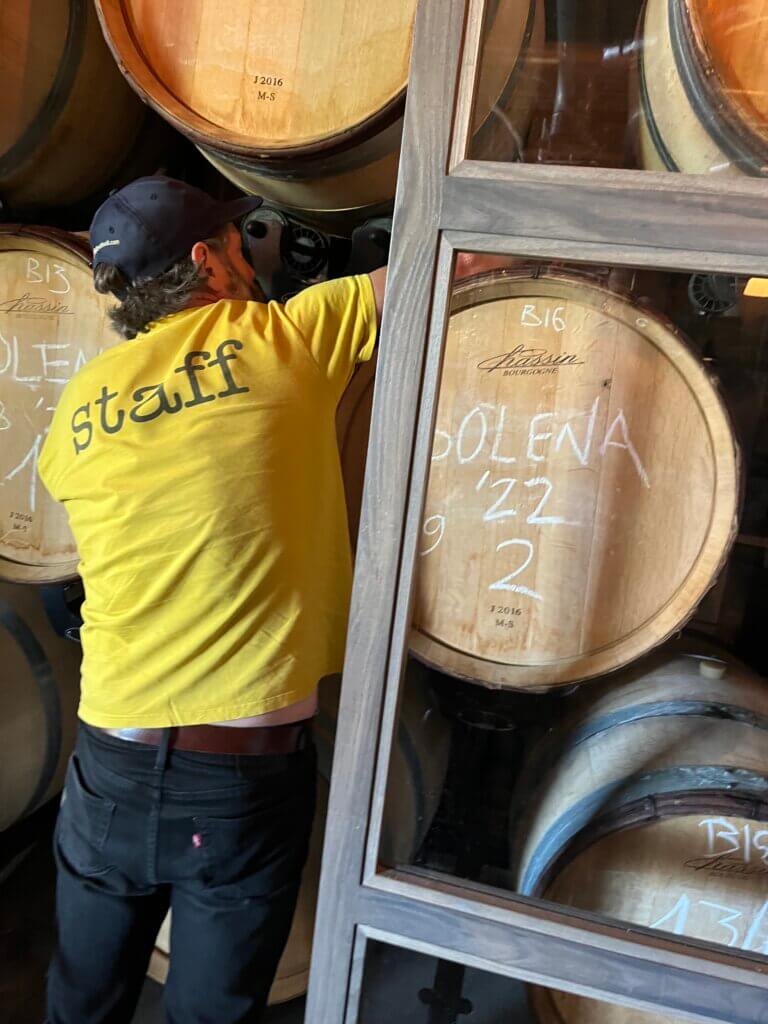

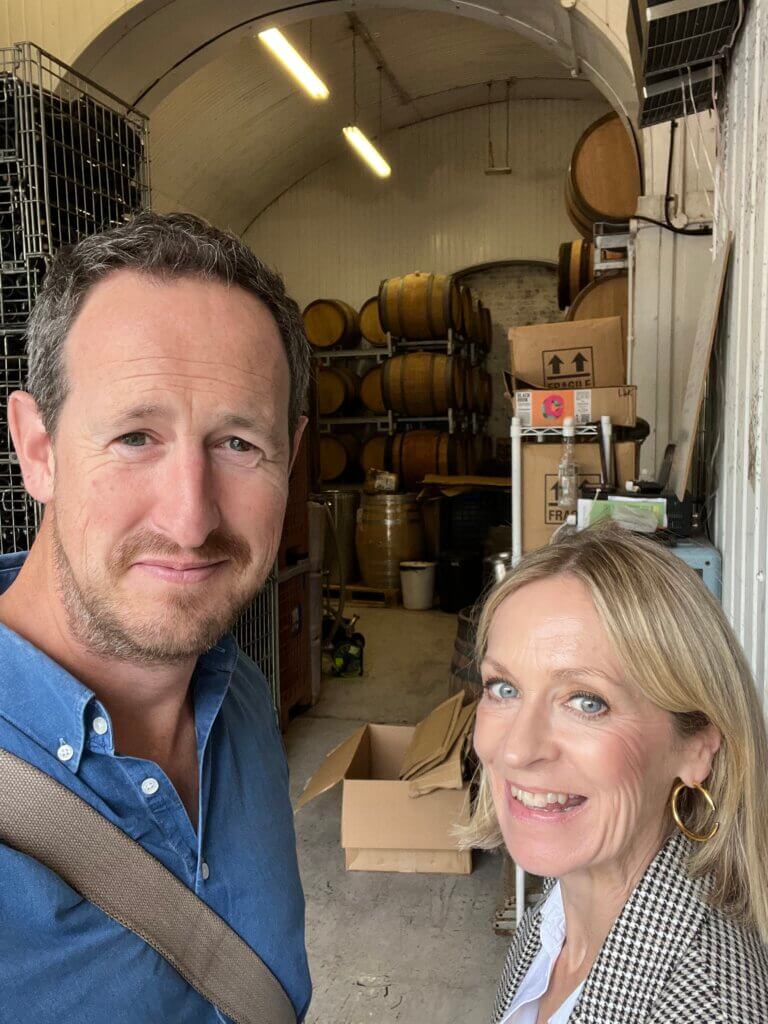

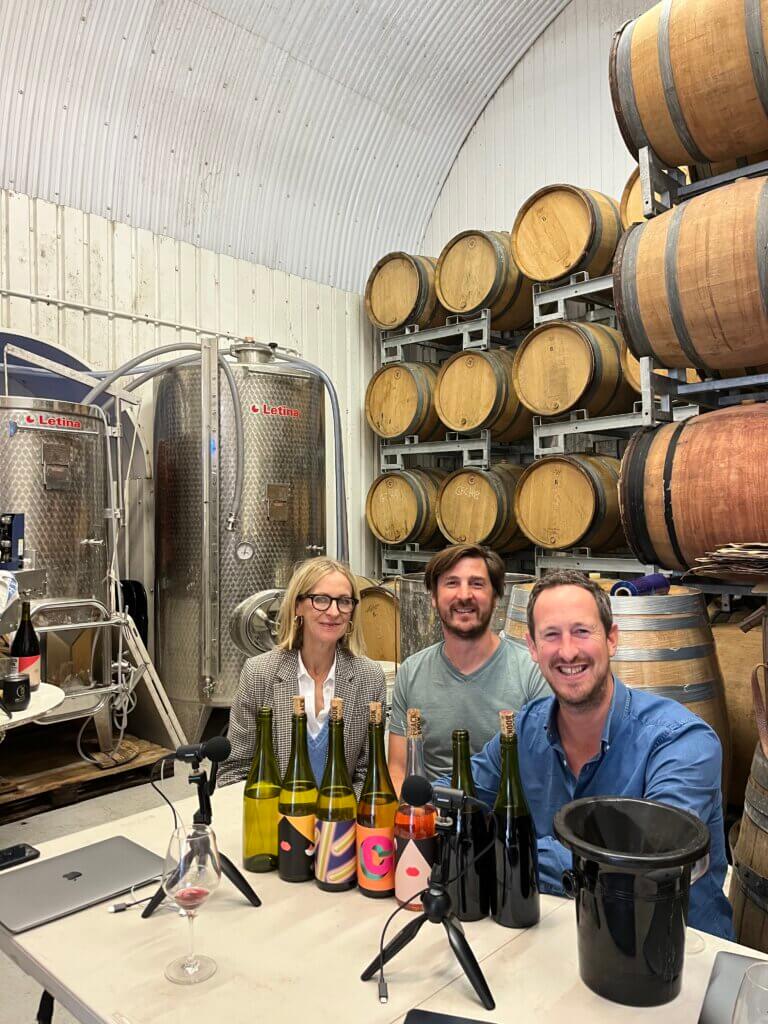
Get in Touch!
We love to hear from you.
You can send us an email. Or find us on social media (links on the footer below).
Or, better still, leave us a voice message via the magic of SpeakPipe:
Transcript
This transcript was AI generated. It’s not perfect.
Susie: Hello and welcome to Wine Blast – what a joy it is to have you here with us! And this is a particularly fun programme that we know you’re gonna love. Because we are getting down with the cool kids doing funky things on the english and welsh wine scene, we’ll be finding out what they’re up to, why they’re doing it and how it all tastes.
Peter: Yeah. Important to clarify from the outset that we are not cool. I know that would come as a surprise to lots of you, but, you know, our children remind us of this fact regularly, every day. Every day. So we are making no claims on that front. To be clear, we are perhaps hoping that, you know, by associating ourselves with these people, some of that may rub off on us, but, you know, it’s sort of vain.
Susie: It’s pretty desperate, to be honest. But, hey, we’re more than happy to give the limelight up to the. To the brave people taking risks, heading gamely off piste to explore dangerous and potentially divisive territory in the quest to make exciting, edgy wines that defy expectations and inject a bit of fun into the UK wine scene. They’re pushing back boundaries and revealing new potential as they do. So that’s something we are all too happy to support and champion.
Peter: Yeah. Apart from anything else, it’s fascinating. here’s a taster of what’s coming up.
Tommy Grimshaw: They’re going to be divisive. Our wines are already divisive. I think they’re only going to get more divisive. You’ve got to be brave enough to produce what you’re really passionate about.
Sergio Verrillo: You know, we’re making naked wines, effectively. There’s nowhere to hide.
Susan Kinsey-Jones: I think people are really up for something different. It seems like they’re quite intrigued by what we’re making and when they actually taste it, people are quite genuinely happy.
Jose Quintana: Everyone should be experimenting. We should be known as the experimenting nation of the world.
Susie: Tommy Grimshaw from Langham, Sergio Verrillo from Blackbook, Susan Kinsey Jones from Whinyard Rocks. And Jose Quintana from Vagabond. There. Now, we’ll be hearing more from all these guys in a bit. And we’ll be tasting and recommending some pretty funky new wave english and welsh.
Peter: Wines along the way, including one of the best english sparkling wines we’ve tried in a long time. which is very exciting indeed.
Susie: It is so good.
Peter: Yeah.
Susie: it is so good. I cannot wait to get onto.
Peter: No spoilers, no spoilers.
Susie: I’ll try my hardest. Yeah. So, anyway, let’s then shift focus to setting the context. Now, I think most wine lovers and certainly loyal followers of this pod are very aware of how exciting english and welsh wine is right now. The quality of the traditional method sparkling wines is well recognised up there with champagne and other great fizz regions. And the best still wines are also starting to gain a, ah, following, you know, particularly the top chardonnays, pinot noirs, rose, that kind of thing of jazz.
Peter: yeah, you know, I think that’s all pretty well established now. Obviously it’s still early days though, you know, this new dawn of world class wine, you know, both sparkling and still, only really kicked off in the UK in the mid to late nineties. Is that fair?
Susie: Yeah, yeah, yeah.
Peter: With the likes, yeah, sort of Nyetimber and Ridgeview, leading the charge with the fizz and then maybe chapel down and gusborne with the stills.
Susie: Yeah, you know. Yeah. But now, you know, the wine scene is, you know, as it starts to mature a bit, what we’re seeing is an increasing emergence of what we might, I suppose we might term, guerrilla winemakers. You know, that the punk rock producers who are not afraid to defy the establishment and explore the world of quirks and kinks outside the mainstream, you know, often to brilliant effect.
Peter: Yes, yes. So that world of intrigue and subversion and creativity is what we’re going to dive headlong into now. we’ll be shifting from a London railway arch to tales of vines being savaged by sheep m in the welsh hills. Can you believe it? I can, actually.
Susie: So can I. Funnily enough, we’re talking dangerous, those sheep and Welsh.
Peter: Anyway, we’re also going to touch on a wine inspired by electric folk music.
Susie: Yeah, yeah. I mean, I was just thinking, I don’t think we’ve actually covered welsh wine before now either, so it’s great to correct that minor oversight that needs correcting. It does indeed. But one thing, one other thing I would say is that these producers tend to be smaller players, you know, the Davids, if you like, in the land of Goliaths. well, I suppose the UK isn’t perhaps that developed yet, but certainly we’re talking the little guys in a land of bigger players, so they deserve our support because what they’re doing is, it is brave and almost always a labour of love.
Peter: Totally. You know, they’re rarely making big quantities, are they? They’re sort of doing things they believe in, but which almost by definition aren’t the most commercial of propositions. but, you know, for a healthy wine scene to develop. It’s important to foster this kind of creativity and buzz. so, yeah, they need support to survive and keep on disrupting and doing interesting things.
Susie: Hence this programme.
Peter: Indeed.
Susie: Right, so where should we begin? I think we should start in the wilds of Dorset.
Peter: Go on, then.
Susie: and I know we’ve given it this big build up about small, less known producers, but we’re actually going to kick off with perhaps the best established and certainly largest of the producers we’re going to feature, which is, Langham Because I just think what head winemaker Tommy Grimshaw and his team are doing is so interesting.
Peter: Yeah. And it’s sort of disruptive in its own beautiful way. Just like grower champagnes have been disrupting that region for the past few decades, as we heard in our episode on that very topic recently. but I don’t want to get ahead of myself here. we want to hear from Tommy. So we visited Langham in the rolling Dorset countryside on a very balmy day, to join the team for some dosage trials, which was fascinating in itself.
Susie: Isn’T it, really was.
Susie: It was, yeah, yeah. But we grabbed some time to sit and chat with Tommy, too.
Peter: It was in a slightly sort of breezy vineyard, wasn’t it? Outside with other people.
Susie: It was beautiful. We should see the picture because it was the most beautiful blue sky, sunny day. but it was a bit windy. but, you know, Tommy is. He’s without doubt one of the most exciting winemakers in the UK right now.
Peter: He’s probably one of the coolest as well, isn’t he? And one of the youngest.
Susie: And one of the youngest makes you feel young, makes you feel old. Not young, doesn’t. Well, might make me feel young, who knows? But, yeah, when you think about it, I mean, he admits, he freely admits he only started working in wine for the beer money, and his introduction to wine was buck fast, so he’s done pretty well. anyway, Langham make unapologetically characterful sparkling wine, their main wines being Corallian which is a chardonnay dominant cuvée and then culver, a pinot dominant blend. And I started by asking him what makes Langham different on the english wine scene?
Tommy Grimshaw: Well, that’s a big question to start with. I think it probably comes down to where we aspire, to end up and I think taking huge inspiration from the top growers in champagne such as Selosse and Agrapart as a starting point. And then, yeah, I think in the winery is probably where we put in the most unique in terms of the traditional method. Sparkling producers in, no filtration, no finding agents or wild yeast based ferments. High proportion of used French, oak on the base ferments as well. And approaching the wine more like producing burgundy perhaps would than, another sort of sparkling wine producer trying to make neutral base wines.
Susie: And if I’m a person going in to buy a bottle of sparkling wine and I choose Langham, what am I going to get?
Tommy Grimshaw: You’re going to get something that’s really approachable. It’s quite developed at a young age, low pressure. So you’ll actually be able to taste the wine. you won’t get a real big aggressive fizz. And I think you should approach it almost like a fine white wine. You know, drink out of a white wine glass. Eat it. So eat food with it and yeah, and just enjoy it. You know, you don’t have to read too much into it. But if you do want to read into the wines, I think hopefully you’ll find those great layers, lots, of complexity and really nice texture to our wines as well.
Susie: I know you like to experiment. What’s the riskiest thing you think you’ve ever had a go at?
Tommy Grimshaw: Everything we do here’s got a lot of risk involved. I don’t know. I think it’s actually just taking that step to be as hands off as you can and just constantly questioning things, you know. We’ve got a one of our reserve tanks got a beautiful natural flor growing on it. That was one, they usually topped fully to the brim, 4000 litres in each tank. They’ve all got their own character. And one of our reserve tanks is much lower in acidity. So a few years ago our rose blender wanted to reduce the acidity on it. So we just drew 300 litres out. So it’s quite a big, head space, which isn’t good for wine. You know, it can oxidise more. even as an oxidative producer, it’s something we have to be aware of. And so that was just before harvest. I thought we’ll get the harvest in, I’ll see what my tank capacity is and then we can move this 3700 litres of wine inside and keep it nice and protected. We came to it in November and saw that this natural flor was starting to develop.
Susie: That’s like a film of yeast over it.
Tommy Grimshaw: Yeah. And it was. I don’t know, I think maybe it gets my better judgement. We kind of thought we’d leave it rather than panic and try to sterilise it and chuck a load of sulphur in it. We thought, well, this could be a good learning exercise. flor is, you know, quite fickle. It needs a specific, constant temperature, it needs to write humidity. Our, ah, reserve wines in concrete tanks submerged underground to temperature consistent and obviously found a nice home. And so we thought we’d just watch it and taste it every single week. And it developed into something really strong and protective. And the wine beneath, it’s really interesting. It’s brought an amazing viscosity to the wine, which I never imagined and it’s been a really interesting learning curve. So that’s 3700 litres wine. That’s probably quite a big risk.
Susie: What are you going to do with it, though?
Tommy Grimshaw: So it’s now part of our reserve. So a lot of it goes into our Corallian because it brings this slight nuttiness, the viscosity that we love, and a real saline profile that brings to our Corallian now.
Susie: Amazing. So just a final question. How do you see the future for Langham? And equally, how do you see the future for the english wine industry in general?
Tommy Grimshaw: I mean, the immediate future for Langham is quite exciting because we’ve expanded the vineyard from, 30 acres up to 75 and next year, 85 acres. And, we’ve got a new winery which we’ll start building next year, ready for June 2025. So immediately, that’s hugely exciting. and that’s the immediate future, I think, 10, 15, 20 years. I’d love to be seeing these wines, throwing punches with the top grower producers in champagne. Just getting started here at Langham. I think. I think probably the same goes for the UK industry as a whole. I think we need to be cautiously optimistic about the industry, not, get too ahead of ourselves and, yeah, not think we know everything and we’re in a perfect place all the time. We need to, we need to constantly learn, constantly improve, get a better understanding of our sites. I think that’s going to be really interesting in 50 years time when these vineyards are well and fully, established and they’ve seen a huge amount of vintages, there’s good data on them and we’ll be able to really start to understand the sites and lots of exciting new producers as well. I think that’s going to be interesting to see what comes next.
Peter: If you can imagine in 50 years, tasting the wine from here, that’s your ultimate dream wine that you could see yourself, the very best wine making here. How would you describe that wine?
Tommy Grimshaw: Ah, It’s really hard to answer that question without, again, talking about the producers that I admire so much. But, yeah, definitely it’s going to be oxidative, it’s going to be rich, it’s going to have long cork ageing as well as long lees ageing. and, yeah, I’d certainly want to. The wines to be head turners and just something distinctive, I think m they’re going to be divisive. Our, wines are really divisive. I think they’re only going to get more divisive. but hopefully the people that love our wines will love them even more. I’m up to win over a few of the critics as well.
Peter: Is being divisive a good thing, then?
Tommy Grimshaw: I think. I think it’s easy to make nice wine. I think nice wine. Everyone goes, oh, yeah, that’s nice. But, I think, look at any industry, the producers that are seen or the brands that are seen at the top of that industry, there’s a lot of people that don’t like them as well. And, I think you’ve got to be brave enough to produce what you’re really passionate about and only then will you be able to produce the best of that style. I think being divisive is good, but not for the sake of it.
Peter: So better to be naughty than nice
Tommy: sometimes.
Susie: Tommy, thank you very much.
Tommy Grimshaw: Absolute pleasure.
Susie: Better to be naughty than nice always. You can feel a t shirt coming on. But, you know, what I admire in Tommy’s approach, and you can taste it in the Langham wines, is this very clear eyed ambition of where they’re heading, what they aspire to, which is to make really complex, characterful, thought provoking sparkling wines in the style of the great grower champagnes, but with an english twist. And they’re not afraid to take risks to do that.
Peter: Absolutely. And I love that stuff with flour, you know, the sherry, yeast. And the best bit is the wines bear them out, don’t they? You know, so we had Langham’s Rosé fizz as our wine of the, of the year last year, didn’t we? And, you know, these are seriously fine wines, as you say. They even pull off low dosage in real style. They do m when actually it’s a rare, traditional method. Cool climate fizz that does that. In reality, their Corallian the chardonnay dominate cuvet is a, lovely sort of invigorating, but also yeasty, biscuity, savoury wine. And the culver, which is the pinot dominant one, is gorgeously rounded and rich. Probably my favourite, I think, the culver.
Susie: But then the rose, as you said, is just sensational. You know, it’s got beautiful balance and complexity. And then the brute natur pinot noir 2019, that’s just heavenly, too. You know, to my mind, it’s definitely playing in the big leagues. And you could put this in a lineup of grower champagne and it would certainly hold its own.
Peter: Yeah. And just going back to dosage, we did ask Tommy specifically why their wine sits so well with low dosage, and he identified four factors. harvesting ripe fruit for complexity to offset the acidity. Then the fact they don’t philtre means the fruit isn’t stripped out in the. In the winemaking process. Thirdly, their oxidative approach helps give clean ferments and again, adds the roundness and complexity of the wines. And then finally, barrel ageing with battanage gives more body and texture from the lees. And all of that makes for a rounded, harmonious wine.
Susie: It’s good to hear they’re expanding too, isn’t it? That’s a positive sign.
Peter: It’s really good.
Susie: You know, apparently. Apparently they got to a crossroads about three years ago when they either had to expand or put the prices up. and to their credit, they decided not to put prices up. in fact, their wines, to my mind, are some of the best value english sparkling wines out there right now.
Peter: Yeah, I agree.
Susie: Would you agree? Yeah. Ah. I mean, Tommy said, until we feel our classic cuvees are competing and beating the best grower champagnes, I’m not going to put prices up to that level.
Peter: Love that logic. Love that logic.
Susie: It’s really fair, isn’t it?
Peter: Yeah, it is. and, you know, it’s good. As you say, they’re growing at tripling capacity, I think, in total. and they’re also making some new things as well. now, we’ve been lucky enough to try a sneak preview of the latest release, which we’ve got right here sitting in front of us. it’s an oak aged, still, not sparkling still Chardonnay called search for enlightenment. It’s, the 2022 vintage, the first one. It’s officially released on the 29 April. We’ve got this sneak preview we did. And it’s not half bad, is it?
Susie: It’s really good. It’s really good. You know, it’s built around, you know, mouth watering. Really mouth watering. Tangy, ripe, lemon acidity. But they’ve managed to round out, you know, round it out beautifully with a lovely creamy texture and nutty, yeasty complexity. You know, I’d liken it to a cool vintage of chassagne, although I know you think it’s more akin to a premier crouch Chablis, but in either case, you know, it’s definitely got that added bit of, you know, sort of steely british stiff upper lip.
Peter: It’s definitely got a tanginess to it, underlying it all. I mean, did you think, just tasting it, do you think they could go even bolder with this style? Do you think they could give it a bit of that sort of snap, crackle and pop? You know, that, sort of more famous rice Krispie pop, flinty struck match complexity into the mix?
Susie: You think they. I mean, I’d love that, you know, because we love that style. and I think the structure here could easily, easily carry that. But this is. It’s a brilliant kind of first attempt. And I reckon, you know, what they’ll do is they’ll fine tune it to what best suits their fruit and their house style over time. But you do get the sense at Langham, there’s so much more to come and it’s really exciting.
Peter: Yeah. Good, good. So, time to move on. Coming up, we’re moving from the rural bounties of the welsh hills to the urban delights of wines made under a London railway arch, As you do, plus dropping in a few other gems along the way. By way of brief recap, the wine scene in the UK is being diversified and disrupted by a growing number of producers aiming to shake things up, making ambitious alternative styles like Langham’s take on grow of champagne and now Chablis, or chassin, depending on who you listen to, this movement goes well beyond England’s staple styles of traditional method. Sparkling wine and still chardonnay.
Susie: It does. How does a glass of lo fi purple welsh bubbles sound?
Peter: Yeah, welsh purple bubbles sound good.
Susie: Too, let me tell you. So, husband and wife team James and Susan Kinsey Jones run Whinyard rocks, a tiny, low intervention vineyard in mid Wales, sort of midway between Worcester and Aberystwyth on the west welsh coast. Now, this is a fourth generation sheep farm. Mentioned the sheep before. We’re back to the sheep, with holiday lets. But James and Susan wanted to do something different.
Peter: Plenty of holidays to wine regions, always a good pastime, which we’d endorse. And as lovers of food, travel and wine, they thought, why not set up a vineyard and holiday cottage in this beautiful part of Wales on the edge of the, the mighty radnor forest. so they planted 800 vines including the red Rondo variety, which will come on to in due course. The only problem being they still lived and worked in London. And as james pointed out, travelling 170 miles to tender vines probably wasn’t the most efficient form of viticulture, but they.
Susie: Proved it was a goer. as their website says, it’s two people trying to make wine on a hillside in Wales, as you do now. I met them recently at a tasting of welsh wine in London and was inspired by their story. So we wanted to get them onto the pod to find out a bit more about why exactly they are indeed trying to make wine, natural wine, on a hillside in Wales.
Peter: So I called up with them and asked them, was there a moment when they thought this could actually work?
Susan Kinsey-Jones: Yeah, I think when we first, for me, when we got our first tiny Rondo harvest and out of that we were able to make some still red wine. that was the very first kind of like experimental go at what we could achieve. And when we got those bottles back and it tasted like wine and it was something we liked, that was a real turning point. But there is a bit of a story ahead of that point that I’m sure James can fill you in on.
James Kinsey-Jones: Yeah, so we’re obviously on a sheep farm and my cousin farms, you know, he has sheep on our farm now. and one stormy night in mid June, so you know, everything’s out in leaf. he for some reason put quite a few sheep in the sort of field adjoining the vineyard and they managed to bust in and eat everything in the year that we were going to have our first harvest. So it wasn’t just a little nibble. They managed to turn like every trunk into a chewed up toothpick. And I was like, my dad called me, it’s been a disaster. I was like, what am I? Okay? But it turns out, yeah, these sheep are busting m. I thought it was one or two, but it turns out it was 160 vines.
Peter: Out of how many did you lose?
James Kinsey-Jones: This is the amazing thing. most of them came back to life and even that year they managed to grow and the following year we got this tiny crop of Rondo, which is why we love Rondo these days. It’s because it’s the year prior that determines the growth for the following year. So somehow Rondo was so robust and resilient, it was able to get over the shock of being eaten by sheep to produce a tiny crop the next year, which kind of like in our mind like Rondo will thank it forever. So being able to produce wine, in the following year.
Peter: So Rondo can survive a savaging by sheep. Yeah.
James Kinsey-Jones: So I’m not even not actually worried about frost this year, you know, with wine.
Peter: And have the wines turned out pretty much how you imagined they would?
James Kinsey-Jones: I don’t know what. Essentially, again, I think slightly naively, when we planted it, we, our preconceptions were that maybe we’d, it would be conventional. But we kind of ended up going down the sort of more natural wine route, out of pretty much meeting our ah, winemaker, mark Smith from Black Mountain vineyard and becoming friends with him because we lived in the same town. and then he said, he said, I can make your wine, but it’s going to be natural because I don’t have any chemicals anymore. So he’s very much of a sort of off grid lo fi winemaker. and at that point we hadn’t sprayed anything, we hadn’t had any sort of synthetic inputs, used herbicides, pesticides, insecticides in the vineyard in any case. So it was a natural fit for us. so we just sort of started playing around with some of the initial harvests and that kind of defined what the sort of wines that we’re producing. And very much it’s. Is to find what comes off the field, really. And each year will be completely different and be a reflection of what has occurred that year rather than trying to aim for a specific style or consistency.
Peter: How important is that lo fi approach to what you do now and in a way, your philosophy and your wine style?
Susan Kinsey-Jones: Yeah, I think it’s pretty much integral to our philosophy now. it’s something that’s kind of evolved over time and it’s now seeming seems to be very much like the fabric of our identity. And it kind of trickles out into other things that we do on the farm and our approaches to things. and just trying to see things differently.
Peter: Yeah. Do you think it helps you stand out? Do you think it is quite an innovative approach in the UK still?
James Kinsey-Jones: I think so. I mean, I guess like we’re Welsh, which probably makes us a little bit different. M the majority of vineyards in Britain are in England. But then I guess if you’re going down the sort of more natural route, then again you’re in a different category again. So I think it has been, it’s opened doors, let’s say, or allowed us sort of access to different, retailers etc, by going down this route.
Peter: And it must be quite hard work now. Yeah.
James Kinsey-Jones: It is hard work, yes, essentially. Well, where we are, there’s not really, We’re not in like a wine part of Britain. So there isn’t like the contract labour. You know, lots of vineyards have contract labour who come in and do this, that and what, you know, the other, whether it’s, you know, pruning, bud rubbing etc, etc. So we kind of. We kind of have to do everything. and equally we made it, you know, doubly difficult because, you know, we. We don’t use the. You know, we don’t use a herbicide under the vine. We will sort of weave manually. So it’s. Yeah, it’s. We’ve made life difficult for ourselves, but I think it’s. It’s kind of, I feel it’s become sort of integral to who we are and what we’re trying to do.
Peter: If you could choose, ah, one wine that you’ve made so far that really captures the essence of what you’re trying to do. What would it be?
Susan Kinsey-Jones: It’s like asking. Favourite child.
James Kinsey-Jones: We’ve all got one.
Susie: Yeah, we’ve all got one.
Susan Kinsey-Jones: Let’s be honest.
Susan Kinsey-Jones: I think.
Susan Kinsey-Jones: I think our Col Rondo is just something that. It was our first. It was our first wine. And. Yeah, the purple bubbles, the, brambles hedgerow tasting like a crumpled bush after a barn dance is just. I think that really sums us up. It’s just. Yeah, we’ve never tried anything like it before. A lot of people haven’t tried anything like it before and it’s just. It’s just. It’s. It’s us. It’s off the hills, it’s off Wales, it’s.
James Kinsey-Jones: And you got to love, a pun based wine, you know, as the person who thought up the pun, I think I forgot to mention that.
Susan Kinsey-Jones: Sorry.
James Kinsey-Jones: I don’t know. We’re not particularly serious people. so I think, you know, having something that’s kind of like. I don’t know, fizzy purple party juice is kind of like. Feels great and then it’s kind of like, interesting and it’s fun. It’s not serious, you know, it is what it is. So, yeah, I think that’s important to us as well.
Peter: So I was going to ask you, how do you find this resonating with customers, with people who buy and drink the wine?
Susan Kinsey-Jones: A good question. I think when we’ve. Yeah, I think people are really up for something different. it seems like they’re quite intrigued by what we’re making and when they actually taste it and when we’re present with people and they’re tasting and people are pleasantly surprised and seem quite genuinely happy.
James Kinsey-Jones: And I think from like. Because I guess we haven’t done a huge number of events, but people locally, first they baffled that someone’s making wine in this part of the world. Then. Then they’re like, what on earth’s natural wine? And then they go, it’s fizzy red wine. So you’re taking them down this, leading down this sort of weird and wonderful path of like more experimental things. But end of the day that, you know, they typically. They, you know, they enjoy it. So, yeah, I think, yeah, yeah.
Susan Kinsey-Jones: It seems to be received quite well. And with, I think people like the fun and, something we’re trying to do, I think that we’ve end up trying to do is trying to make wine a bit accessible and not, you know, we’re clearly not from like a lineage of, viticulture where we are. There’s no like deep rooted history. So, it seemed like we’d miss the point by trying to pretend like we’re part of like a long line of grand estates of, you know, centuries of grape growing. so I think if we try and position our wine as something that is just kind of. If you like drinking and you like wine, then pretty much give it a go. That’s, that’s, great.
Peter: It’s a fabulous approach and I totally congratulate you for it. guys, thank you so much for your time. Thank you.
Susan Kinsey-Jones: Thank you.
Susie: You gotta love that story, especially the sheep. And they’re brilliant people, aren’t they, too?
Peter: Yeah, yeah, yeah. You know, at one point they described themselves as belligerent, because they just wouldn’t be told no when they were first embarking on the project. And this partly because their site is not only fairly wet and this being whales, anyone who’s been on holiday to Wales there will know just that, you included. but also because it’s pretty remote and relatively high altitude at 230 metres above sea level. When most people say that anything over 100 to 150 metres in the UK can struggle to ripen properly.
Susie: I mean, but that’s presumably why they’re using hybrid varieties like rondo and solaris, because they’re more disease resistant and they can harvest a bit later.
Peter: Exactly, exactly. and they did admit their yields are painfully low. their rondo is the best yielder and at best they get is about four tonnes per hectare, whereas apparently elsewhere in the UK, it can yield up to twelve to 15 tonnes per hectare, so up to sort of four times more. But, you know, I mean, they’re hoping to grow a bit and demand from retailers is currently outstripping supply, so that’s good news. They’re, aiming to push the holiday cottage, which they describe as idyllic and tranquil, which I can quite imagine. Sounds wonderful. and they may even do something on the foodie front in the future, too, so.
Susie: And we’ve tried their col Rondo Redfiz, haven’t we?
Peter: And it’s exactly as described, really. fun. Definitely different. it’s a col fondo method, so refermented in the bottle, but sold hazy with the yeast leaves still in there. And it’s frothy and it’s juicy and it’s bittersweet. It’s a bit earthy. Perhaps maybe one for summer barbecue quaffing. Dunno, you know, with some welsh lamb. Butterfly. Welsh lamb on the. On the barbecue? Why not?
Susie: And purple. Welsh bubbles. Who knew purple?
Peter: There we go.
Susie: Right, moving on from the valleys to vagabond, the wine bar chain famous for their whizzy enomatic machines dispensing all kinds of wines in handy small portions, including their very own english wines, because vagabond has a tiny urban winery at the back of its Battersea venue, which is next door to Battersea power station.
Peter: Yeah, it’s pretty cool. urban wineries have definitely become a thing in London now, which is great for people to discover. that said, as this goes out, vagabond has just been taken over by majestic wine, so things may change in the future. nevertheless, we.
Susie: Hopefully not too much.
Peter: Exactly. Hopefully not too much. We sort of. We headed in, didn’t we, to talk to vagabond winemaker, Jose Quintana, who buys his grapes from vineyards in Oxfordshire, Essex, Suffolk and Sussex before he works his magic on them, in south west London.
Susie: Yeah, we featured Jose’s skin contact, Ortega, called Solena in our episode on Orange Wine. And as he’s a self, self confessed tinkerer, we wanted to ask him specifically about his funkier wines. now, I should say we were talking in their battersea bar winery, so it wasn’t without some background noise.
Peter: Lots of people enjoying their wines.
Susie: Jose, by the way, has a spanish heritage, and worked as a sound engineer and in property before training at Plumpton. And he started by talking about the Bacchus grape variety.
Jose Quintana: So we do. I, have a tricky relationship with the great Bacchus. Ah, it makes wonderful wines that are very approachable from a commercial sense because they’re so, expressive that they’re very, very kind, to drinkers that perhaps are, ah, new to wine because the aromas are so present and so obvious that they feel comfortable smelling those. But for me, I find them too, in your face. and I wanted to try and look at a way of building texture restraint, in tobacco. So we have tried to do a wine that, it blends in some skin contact bacchus with some barrel fermented bacchus. And that’s inspired from some of the wines I tried in Sicily where they use cataract and they use a small amount of skin contact to add texture, to add depth, complexity and layers. And some of those small spicy notes that you can get from doing these, these things gives for me, the bacchus a bit of more of a journey, that isn’t just aromatics and then a thin palate. so I’m trying to look at ways that we can develop bacchus in a different way of maybe sort of elevating it and giving it restraints. so we do that and that’s a lot of fun. That’s called dios mio, because dios, mio in Spanish means sort of, oh, my God. and it was a bit of a journey on the first time we made it. And sometimes I come into the winery and you’d think you’d have to throw it down the sink. It was, oh, my God, I’ve ruined it. And then a week or so later, it would completely come round and it was, oh, my God. So we call that. And Bacchus being the God of wine, Diosmia. Anyway, then we do, a nice, experiment. Wine that we’re doing is with Ortega skin contact. I used to work with Westwell, with Adrian. He does a lot of work with Ortega skin contact. So what I did here was when I joined, I was, handed a baton of, a barrel of Ortega skin contact from the previous, winemaker. But rather than just release, it as here today, gone tomorrow, so the wine, we decided to start a solera system. I’m a bit of a sherry nut and I love sherries. And so the idea of. To create an ageing system, or use the idea of solera to age Ortega wine, and the skin contact gives it that extra ability to age and stay fresh.
Susie: What do you think the solera will bring to it then, rather than make it a vintage wine.
Jose Quintana: So what it brings to it is depth. every time I taste at the moment, we’ve got two levels of the solera. we’ve got a wine from 2022 and then a barrel of the blend of 2018 and 2021. And just tasting them, the rich of spice, that gets this christmasy spice. It starts off as a sort of tangerine y, light, spice. But as it ages, the spiciness, the sort of cinnamony nutmeg spice deepens and deepens, and you start to lose a touch of that, fresh tangerine. And it goes very much into dried tangerine marmalady character. And then, but it, but it has a, has a, sort of a slow process of this. And so then it sort of really suits the solera system of being then able to go and blend from that deep, rich character to the, when you have skin contact. Ortega in its initial year, it’s, it’s all very floral honeysuckle, honeyed, that fresh tangerine fruit comes through some m ginger spice, that sort of thing. So it lifts it all up and then it takes this sort of brooding spice of the aged Ortega and to be able to sort of play around with that and release sort of, bottles of that blend each year. For, me, it’s a bit like, say, where you get ageing in champagne, where nothing can circumvent it. You can’t get to that taste and experience and flavour by anything else other than time. It’s the same for me with this ageing, the wines now, I have no idea where it’s going to go. And the oldest barrel we’ve got might next year just be, you know, gone and, you know, and not really work anymore. But that’s experiment. And the symbol of agabond is the fox. The idea being that it’s this creature from the country that’s come into the urban environment and is having to adapt and it’s sort of on its own loved by some, hated by others, but having to be creative, having to sort of duck and dive a bit and do some, different things to try and survive. And that’s the idea with the winemaking as well. We don’t have the weight behind us to sort of stick 200,000 bottles on the supermarket shelf. So we have to get a story across to people. We have to connect, people with the wine, but on the limited releases, that captures people’s imagination. And last year, was quite, ah, an exciting wine came about from nowhere, sort of serendipity I got offered some grapes that I wasn’t expecting, and it was from a vineyard we already worked with. And we got offered half a tonne of a mixture of pinot gris and sauvignon blanc from, from Essex. And I don’t like to say no to these things because if you say no, then you don’t get offered it again. That’s that sort of thing. But I had nowhere to put it. We did what we had nothing. No other way than to just put, we crush the grapes. Pinot gris sauvignon blanche, destemmed, crushed into a doughlab bin. So it was co fermented, on skins for seven days. and then we pressed off. And once a barrel became free, we went into barrels, one barrel. and I love skin contact pinot gris, skin macerated pinot gris. I think in Alsace they do some really great wines. So interesting to see and, interesting to see what the sauvignon blanche was going to bring to it. Absolute experiment. I’ve never tried a pinot gris Sauvignon blanc co fermented skin contact wine in my life. And we’ll see what happens. And, it’s now been released, the limited release of, like, 280 bottles under the label night tripper, that has just. That’s already sold out.
Susie: and we’ve tasted it and it’s really good.
Jose Quintana: Yeah, we only released it a, couple of months, a couple of months ago. And, yeah, again, a wine that’s not for everybody. A slightly raised price point as well. But when you tell people the story of the wine and it’s something interesting and, weirdly, I think it works, I would never have guessed it, but Pinot Gris has this quite fat, glycerol y character. And then. And it was really ripe. You know, it came in at 13% natural alcohol. But the Sauvignon blanc acidity, the palate balancing that out, giving this sort of star shaped, prickly acidity, just, just for me, it really works. And, so now the night tripper, is going to be the experimental wine every year. So, I’m going to be pinot gris based. But if I get a little offered, a little bit of riesling or something like that, it’ll go in, it’ll all go in. It will be, you know, chucked in together. we’ll see what happens. And some of them are going to work, and some of them aren’t going to work, but if you don’t try.
Peter: Don’T know, you talk about your story. English wine is new for many people. You’re then making funky, fun english wines, cutting edge, you know, challenging perceptions, challenging norms. Does that just add to the story or does that make it harder to sell, for people to understand and appreciate it.
Jose Quintana: I’m making creative wines because I. I like to create, first and foremost. So I’m making wines that I want to make. And I’m incredibly lucky to be able to do that. I’m incredibly lucky to be making them in a. In a setup whereby we have an opportunity to hand sell and tell the story of those wines to the guests. So, first and foremost, the reason for the success of the winery is the success of the brand and the success of the route to market. And we have a route to market whereby the people and my colleagues in the bars, who I go round and constantly telling them about the wines and engaging with them, enabling them to tell the stories, enables us to make these slightly different wines and unique wines. because they are not just. If I made these wines and I had to make a million bottles of them and stick them on a supermarket shelf and let them sell themselves, I would not make the wines I make. It would be commercial suicide. So where that fits in the grand scheme of uk wine, I’m not really sure. I’m exasperated sometimes at how the UK wine industry thinks that it already knows everything that it needs to know and is ready to start thinking about protecting that. That we somehow know what we’re best at already, only having been done doing it properly for 40, 50 years. I think it’s crazy. And we should be expecting. Everyone should be experimenting, should be encouraged. We should be known as the experimenting nation of the world. We have such a unique climate, we have such a unique, variety of microclimates and soils in the country, from granite to limestone to chalk to clay to sandstone. Why aren’t we. Why isn’t everyone experimenting? I don’t understand. Yes, it comes with commercial pressures, but I think experimentation can be marketed as much as tradition.
Susie: Everyone should be experimenting. I totally agree, don’t you? And we are really. We’re really fans of his funky wines, aren’t we? Like the night Tripper 2022, this mad pinot gris Auvignon blend that’s totally wacky. It’s got this mad Lucazade colour to leathery cherry and dried flour aromatics, and then succulent textured palate. It’s just really different. And most importantly, it is delicious.
Peter: It’s more delicious than Lucazade I’ll tell you what we’re talking about. Old school Lucazade, aren’t we? Mad colour, hasn’t it? But it’s really. Yeah, totally off the charts, but it’s great. And then the salena, the skin contact Ortega from Solera. That’s really impressive too.
Susie: Yeah, yeah.
Peter: now, we should explain this point that for anyone who doesn’t know, a solera is a fractional ageing system, common in sherry, also, used in champagne and some UK sparkling producers. Now, whereby you keep a job, lot of wine aside, take a bit of wine out of it every year and top up the reserves with a bit of new wine every year. So it gradually gets more and more complex over time.
Susie: And then you can use that just to change the subject slightly. I did ask Jose about price, which is something we haven’t discussed yet, isn’t it?
Peter: Yeah, good point.
Susie: A lot of these wines aren’t cheap.
Peter: Yeah.
Susie: We have to say that Jose’s are around 18 to 40 pounds, which is relatively typical in this context. but he made the point that these are artisanal products with no economies of scale or equipment, pretty much handmade with love and attention. So a, slow process using quality, raw ingredients that do not come cheap. But even then, his wines do sell out because people buy into the story of what he’s doing and I think that’s what’s important. That’s great.
Peter: Yeah. And I think that applies across the board.
Susie: It does, yeah.
Peter: M and I remember his quote to us when he visited, Jose said, I’m not after making perfect wines, I want to make honest wines that have something to say. Wines with a cheeky smile.
Susie: Hopefully, majestic will want to keep that connection. I think. I think they will, I think they will. And Jose is a brilliant winemaker. Yes. But anyway, we need to move on. just down the road, we, are going to Sergio and Lynsey Verrillo who are making a unique, quirky range of wines out of a railway arch near Battersea park under the black book label.
Peter: Yeah, that was a slightly busier venue, wasn’t it?
Susie: It was indeed.
Peter: Small, sort of cramped railway. Very small, overflowing, flowing with barrels and eggs and boxes and bottles rush out.
Susie: When you say eggs, you don’t mean, you know, the ones that you’re going to scramble.
Peter: No, I know. They weren’t scrambling.
Susie: Big eggs.
Peter: Big eggs. You put wine in to make the wine. Absolutely. and we had all these trains going overhead and loads of forklifts and lorries bustling and beeping. Around outside. It was a, ah, proper hive of activity as you’ll hear. It sounds a bit like we’re in a sort of steel works.
Susie: It does.
Peter: We’ve been fans of Blackbook ever since we were blown away by their first painter of light Chardonnay source from a vineyard in Essex. Barrel fermented in this very arch, you know, just delicious wine.
Susie: Yeah. And they’ve been ploughing their own unique, quirky path since then, including playing around with pee wees, which are hybrid varieties like Sauvignac and cabaret noir. And they’ve been trying out all kinds of different winemaking vessels and techniques. Now, Sergio’s originally from Connecticut in the US and had made wine all over the world before settling in London. I asked him about his winemaking philosophy.
Sergio Verrillo: To be as self indulgent as possible. No, it’s, my general philosophy. We specialise in Pinot noir and Chardonnay. That’s my love. That’s why I travelled the world learning and making in different climates and high end boutique wineries and vineyards. So that’s particular range. We really tried to polish it and make it refined and make it better. Now, where pee wees and other types of experimental wines come into play is in a rightly apt name called experimental range. And these are blends, these are wines that are non pinot and shards, at least not as single varietals. and so by rolling these, varying wines out, that we sort of push the boundaries a bit on allows us the freedom to then apply that to the core range if it works. So the philosophy that we stand here is really first and foremost, it’s all about the vineyards. And, you know, there’s a philosophy that’s widely said throughout the winemaking community, which is you can’t make good wine or great wine from bad grapes, but you can make crappy wine from great grapes. So we really focus a lot of attention on the vineyard. But once it gets here, we really sort of try to coax texture and, length and mid palate out of the wines. and we do so by using indigenous yeasts. all the wines go through malolactic, naturally serve indigenous bacteria as well. we use a lot of barrel work, to do that. Varying size barrels. I mean, we’re surrounded by.
Susie: I don’t know, I was going to say we’re sitting here, aren’t we? Every tiny corner has got a barrel in it.
Peter: So.
Susie: Yeah, we can see that you’re, keen to use barrels.
Susan Kinsey-Jones: Definitely, yeah.
Sergio Verrillo: And, you know, and we use eggs and we use stainless steel. And so it’s really a matter of trying to work out what works and what doesn’t. we use between ten or 40%. That was my cellar hand screwing something up, losing.
Cellar hand: All OK!
Sergio Verrillo: and so we, Yeah, we really try cook’s character and ten to 40% new oak goes. And mainly our shiny and pinot noirs. but it’s. Yeah, it’s ultimately trying to get the best out of what we can and without being too interventionist.
Susie: So which wines over the years would you say have been the most successful for you?
Sergio Verrillo: I think given that out of the gate, our 2017 Chardonnay was probably really.
Peter: Well.
Sergio Verrillo: I know it’s very well received and that sort of stuck with us. Our painter like Charonay has certainly been one of our top sellers. our Pinot noir is quickly coming forward with that as well. our rose has been surprisingly one of our really great sellers as well. and interestingly enough, you talk about weird and wonderful varietals. And what started the entire experimental range was our Cole Fondo save a blanc. GMF. And despite its cloudy appearance and austere and sort of tantalating acidity, it is one of my favourite wines and seemingly a lot of other people.
Susie: GMF.
Sergio Verrillo: GMF, yeah. Can you explain that?
Peter: Yeah.
Sergio Verrillo: so it’s an experimental range. Sounds fun. basically it revolves around music that my wife and I like and the Lenin transport system. So, all the tiles you see on the bottles, the big c on controversy, all stems from an element of the Lenin transport system. In a previous life, I used to work in music. I worked for record label in New York and Connecticut and as a work runner for AEG and concerts and et cetera. And so both music, and concerts still are a big part of my life and my wife’s. And so with our first wine, GMF, we named, it after a song by this really amazing electric folk guy called John Grant. This american artist has had a very turbulent middle, life and has come out of it on top, making the most incredibly beautiful music. And GMF, or greatest motherf*cker, is, one of our absolutely dear favourite songs from him. So that’s for that. But we also have, like, the mix up, which is our white blend. And that’s, a beastie Boys album. And so, you know, if you money.
Peter: Wasn’T an issue, develop the urban winery of your dreams in London. What would it look like? Ooh.
Sergio Verrillo: I mean, this, again, very self indulgent. It’d be a place I’d like to go to. You know, it’s sort of very focused on music with, like, live bands playing and sort of like, we’d have really great wine and we’d have amazing vibe where people come and hang out. we’d potentially sort of incorporate a kitchen, you know, partner with a chef that is already existing and sort of get this, like, food and wine element happening, but a very casual environment. And so just make it a meeting place, a place where people can just come and hang out and enjoy themselves, and not feel a need that they need to sort of bring their pocket guide of wine with them to understand how to drink. So it’s, you know, I grew up in a very unpretentious wine households. and that’s kind of stylistically what I like to bring to the table where I like to go drink. So.
Susie: So do. Thank you so much.
Sergio Verrillo: No, thank you, guys. Absolute pleasure.
Susie: I do love the sound of that winery come bar, come kitchen, come music venue, you know, it sounds so cool.
Peter: Yeah, it sounds way too cool for us.
Susie: Too cool for us.
Peter: We’d be the. The nerds in the corner with our pocket wine guides and writing tasty notes. But, no, I agree. It would be great to see black book take things to the next level. you know, I feel they may need a bit of investment or maybe a partner to make that happen. So if anyone out there fancies investing in a cool business, then reach out.
Susie: Yeah, yeah, yeah.
Susie: It would be great to see black book, really, you know, push on. You know, we’ve been fans, as you say, for a while, and we still love their painter of light Chardonnay. We tried the reserve, the 2019 reserve painter of light recently, and it was toasty and nutty and zingy. So complex, savoury with that kind of electric undercurrent of acidity. And. Sourced from Essex, of course.
Peter: Yeah, yeah. And we’ve got. Right here, we’ve got the new Essex Pinot noir.
Susie: Indeed, don’t we?
Peter: The Crows Lane estate. M trouble every day. Pinot 2020. They always have cool names, these ones. It’s full of kind of stem, sappy red fruit flavours, some floral notes, and then a lovely sort of tangy, bittersweet finish.
Susie: Yeah.
Peter: Sort of lighter side, isn’t it? A bit rustic, bit natural. It’s lovely, though, but really appealing, isn’t it? right, okay, so this has been a really long episode. We need to wrap things up, but before we do, we wanted to just name cheque a few other producers and wines who are doing good work in this sort of alternative sphere in the UK, didn’t we?
Susie: We did, we did. And first up, I want to give a big, massive shout out to Domain Hugo, south of Salisbury in Wiltshire. Now, they farm biodynamically and use wild ferments, amphora, no, added sulphur, all that kind of stuff. They really impressed me at the YNGB awards last year and we’ve just tasted the latest release of their fizz, which is the domain Hugo single vineyard, brut, nature. And it blew us away. Stunning is the only word.
Peter: so much character and depth. I mean, we got it here, haven’t we? It’s been. It’s been going on. We’ve managed to eek it out over weeks.
Susie: It nearly went in, you know, within the first place.
Peter: It nearly did. It’s so full of nutty, yeasty, bready roasted apple flavours with a sort of funky, oxidative, nutty complexity. Sort of shades of fino sherry in there, which we absolutely love. You know, the texture is wonderfully mouth coating and fine, but rich. It’s sort of fizz in surround sound. it’s very artisanal. offbeat, eclectic, but beautifully done. It’s a different dimension to english fizz.
Susie: Yeah, I mean, I feel sort of like a beautiful piece of that fresh sourdough with warm butter and caramelised apples. And, you know, what’s also surprising is so much depth for a no dosage wine. It’s so well balanced and it’s even hedonistic. I mean, when would you say that about a no dosage wine from England? Anyway, sensational. Another one to pick up on is the Wharie experience in the new forest, where winemaker Guillaume Lagger sorry if I’m not pronouncing that quite correctly, Guillaume, but Guillaume’s originally from Switzerland and he is doing weird and wonderful things across a range of styles, including orange Bacchus and making peewees like Orion and a pretty punchy cabaret noir.
Peter: Yeah, I think he’s also doing beer and, cider as well. Some really interesting things.
Susie: Well worth seeking out, I think. The Wharie experience.
Peter: Have a look. I’d also mentioned Westwell. we had them on our Red dawn pod episode back in November 22, of course, and recommended their field red blend there. But, they do really interesting things across fizz and white, too. we’d highlight their still Pinot meunier 2022, which is really yeasty and tangy, but also quite rich in texture. Also, we’ve got here, their Ortega skin contact 2022, which is really elegant and age worthy. Orange wine with very sort of fine mouth coating, Tannin. Very sort of cultured and food friendly.
Susie: Yeah. And we mustn’t forget also their late release, Blanc de Blanc zero desage 2013, which is pretty special too. you know, nine years on the lees and so complex and invigorating. yeah. But anyway, but to finish off, I just wanted to head back to Wales and mention Ancre Hill, a biodynamic minimal intervention producer just outside Monmouth in St east Wales, which makes a range of funky stuff. And we particularly liked their red pet mat method, ancestral non vintage, didn’t we? Made with triomphe and Chardonnay. It’s, really characterful, full of strawberry and bruised apple flavour with an oxidative kick, but also really well balanced. it’s a bit crazy, but it’s great fun.
Peter: Yeah, and it’s pretty well balanced for Petna, isn’t it? Nats can often be just a bit dull and a bit thin and a bit dry, but this one’s fleshy, is dry, but it’s got character and balance. It’s a lovely coffee wine.
Susie: Yeah.
Peter: And talking of crazy, there, orange wine 2022, which I’m looking at now, packs quite a punch. Very cool label. Made by a tattoo artist. We’ll put a pickup on the. On the site. it’s very funky, isn’t it? Very tannic, maybe a bit too acidic and a bit too nail varnishy for me. But you liked it.
Susie: I did, I did, yeah.
Peter: Yeah.
Susie: You’re being unfair.
Peter: It’s.
Susie: I mean, it’s mainly Alberino, which accounts for the acidity, along with Chardonnay, Solaris and Ortega. aged for a while in the bottle and it is a bit out there, but I like the slightly exotic kind of kumquat fragrance and then that chalky, yeasty palate texture that you expect from an orange wine. And I also actually think, to be fair to it, it needs the right food. It needs something quite rich but rustic.
Peter: Well, I think that’s rich but rustic. An appropriate note to end on what an adventure this has been. We’ll put the wine details, photos and links up on our website. Show notes. So do cheque those out. Meantime, by way of closing summary, England and Wales now has its very own counterculture wine movement, with exciting things being made all across the spectrum, from petnat to orange to alternative traditional method, even to purple Welsh bubbles. the wines aren’t cheap, but they are worthy of your time and attention, as I hope we proved in this episode, which we have very much enjoyed making.
Susie: We really have. and here’s to more of these fun, you know, funky wines appearing in due course too, and people seeking them out. It’s a sign of a healthy, diverse wine scene. Ah, thanks to Tommy Grimshaw, Susan and James Kinsey Jones, Jose Quintana and Sergio Verrillo And, of course, thanks to you for listening. Until next time, cheers!
